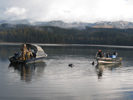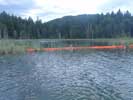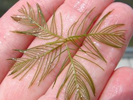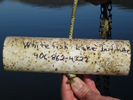Beaver Lake Initiative


Zebra mussels aren’t the only invasive species that can impact Whitefish Lake and our local economy. An Aquatic Invasive Species (AIS) response team—of which the Whitefish Lake Institute (WLI) was a member—responded to the discovery of Eurasian Watermilfoil at Beaver Lake in 2012. Bottom barriers were placed over the identified patch and a control/eradication plan was developed by a multiple agency workgroup in which the City of Whitefish and WLI participated.
Why We’re Concerned
Whitefish has prioritized this effort due to the proximity of Beaver Lake to Whitefish Lake, including hydrologic connectivity. If left untreated, EWM forms dense mats of vegetation on the surface of the water that can interfere with recreational activities such as fishing, swimming, and boating, and that threatens the health of the water body. The resulting effect can be the loss of recreational use, decline in ecosystem health, and a decrease in lakefront property values. EWM reproduces successfully and very rapidly, making it a threat to any water body it invades.
Ongoing Efforts
Since 2012, WLI and the City of Whitefish have taken the lead in addressing the EWM issue at Beaver Lake. As part of the Whitefish AIS Management Plan, WLI coordinated a suction dredging operation to eradicate plants. Suction dredging involves a diver identification survey of single plants or plant communities and then suction dredging the plants from the roots to prevent fragmentation. In 2012, 23.5 pounds of EWM was removed. The program proved successful with fewer plants found each year. In 2018, diver surveys found no EWM in Beaver Lake indicating that EWM management efforts in Beaver Lake had been highly effective.
Unfortunately, in June 2019, EWM plants were again found near the boat ramp by a Montana Fish, Wildlife & Parks (FWP) survey crew, and FWP assumed management of the Beaver Lake EWM issue with support of WLI staff. FWP divers found a small number of EWM plants and utilized a WLI suction dredger to remove them. After suction dredging, FWP also installed bottom barriers supplied by WLI near the boat ramp. WLI continues to maintain a sediment curtain near the lake outlet to Beaver Creek to eliminate the potential for downstream drift of plant fragments to Beaver Creek and Whitefish Lake. WLI also conducts an annual AIS presence/absence survey on Whitefish Lake. No EWM or other invasive plant species have been found in Whitefish Lake. These efforts will continue in the future.
Because of the real threat to Whitefish Lake and the watershed, Montana Fish, Wildlife, & Parks—in partnership with WLI—will continue monitoring and suction dredging Beaver Lake until there is confidence that the EWM has been eradicated.
See all the organizations who are partnering on the Aquatic Invasive Species efforts.




